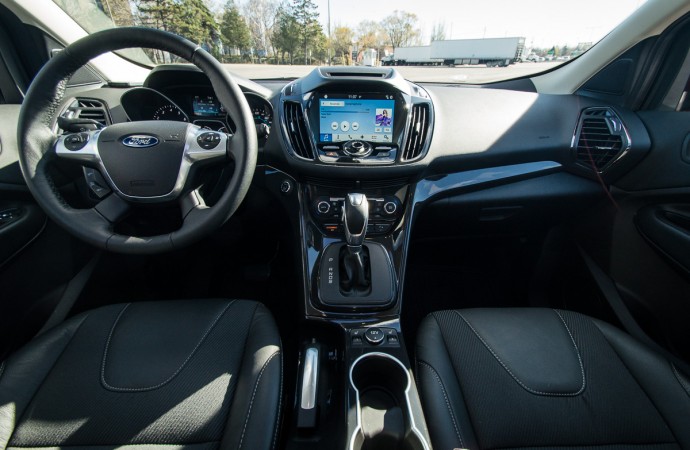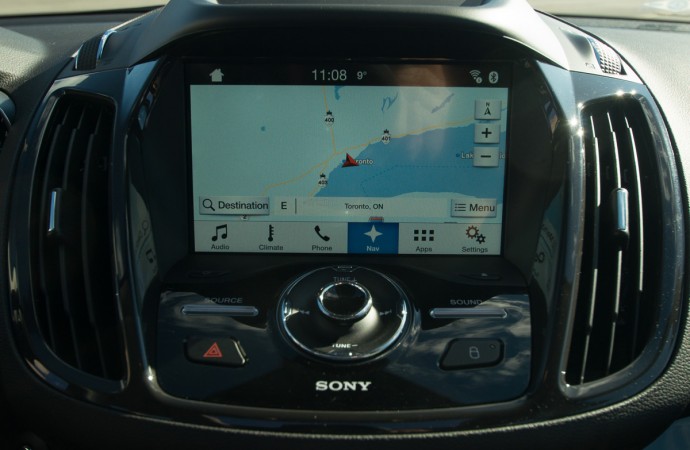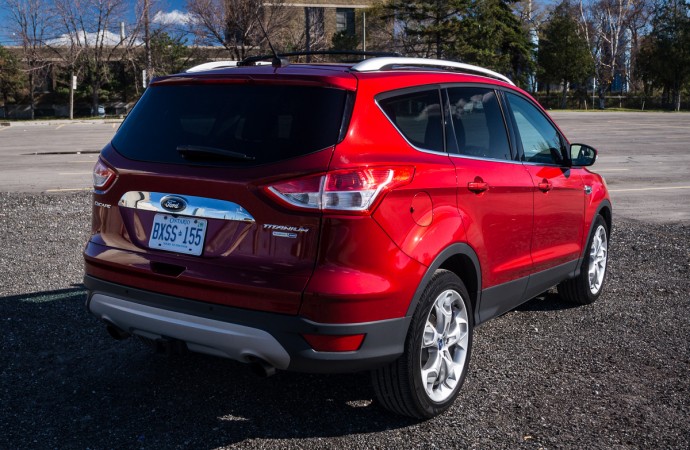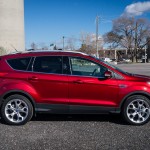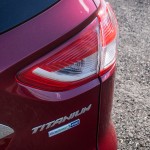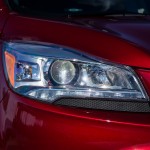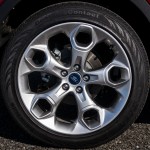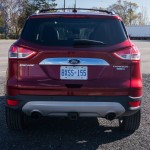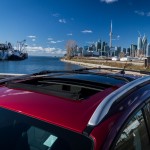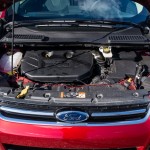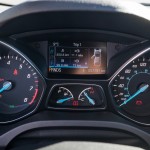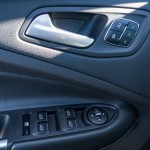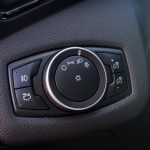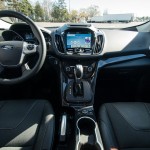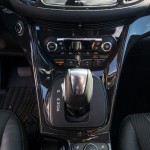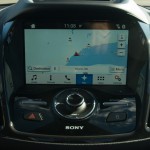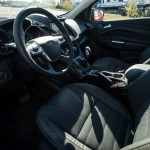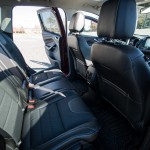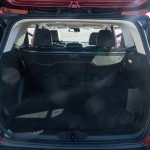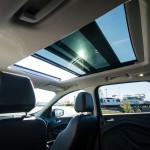With the station wagon largely falling out of favour in the North American market, the crossover sport-utility vehicle has reigned supreme for the last ten to fifteen years, with the heightened sightlines compared to a wagon, extra ground clearance for light off-road duty, without the harsh ride and fuel economy penalties seen in a full-sized, body-on-frame truck or SUV. Four and six-cylinder engines are the norm, and equipment levels have been increasing year after year, approaching luxury-car levels. This week’s Ruby Red 2016 Ford Escape Titanium test vehicle is the latest from the Detroit automaker in the compact sport utility market, an area in which they have excelled in since the Escape’s introduction in 2012.
The biggest change for the 2016 model year is a brand new infotainment system, dubbed Sync 3, to replace the much-maligned MyFord Touch system. The old setup was almost universally disliked, and Ford is looking to redeem themselves with a new system built atop QNX, an operating system also seen in the highly regarded Chrysler UConnect. Will the shift to QNX be too little, too late, or will it help the Escape hit it out of the park?
In the exterior styling department, the Escape makes use of many hard edges and creases to create a fairly aggressive statement relative to some of the more cute offerings in its category (Chevrolet Equinox, Honda CR-V, Toyota RAV4, and Subaru Forester, among others). The Titanium gets an LED light strip underneath the high-intensity discharge (HID) projector headlamps, and although it gives the Escape a bit more of a premium feel, it’d look even better if implemented as a light-pipe style rather than the separate LEDs. Ford may have elected to do this to differentiate the Escape from its luxury platform-mate, the Lincoln MKC. Rounding out the outside, there’s an attractive roof rack and power panoramic sunroof, combined with fantastic looking 19-inch aluminum alloy wheels with a nickel-luster.
For the last several years, Ford has done very well with interior design, carrying on the sharp lines from outside through to the inside. Material quality is above average, with good touch points and ergonomics. Seat comfort and lateral support on the partial leather-cloth seats are good, with power adjustability and heated seats for those up front. Taller or wider front-seat passengers may take offense to the shape of the centre stack, which may interfere with leg and knee-room.
In the rear, the bottom seat cushions appear thin, but are still comfortable, with the low profile allowing them to fold completely flat for hauling cargo. The rear liftgate is power-operated, and when combined with a proximity key system, the Ford has a nifty feature that can open the liftgate by waving one’s foot underneath the middle of the rear bumper. This solves the issue of fumbling for the remote when carrying large or awkward cargo.
For the clumsy, or for those who would rather not risk “parking by feel”, the Escape Titanium can be equipped with a self-parking system for parallel parking. When engaged, the system instructs drivers to position the car just ahead of an available parking spot that’s detected by the vehicle. The only inputs required are shifting into and out of reverse, and easing off the brake pedal to allow the vehicle to move. Steering inputs are entirely automatic, and the system parks the car with stunning accuracy, even at night. While the system has a great value in congested urban centres that are more difficult to park in, it was a huge novelty to be able to park with both hands sticking out of the sunroof. What a time to be alive!
For media connectivity, the Microsoft MyFord Touch system has been replaced with a QNX-based setup, known as Sync 3, that has become the piece de resistance of the 2016 Escape. While the look and feel of Sync 3 isn’t quite as sexy as the one it replaced, the interface and menu system has been greatly simplified, and is fantastic to use. Every button press is intuitive, and Sync’s voice command remains a strong suit; speaking out navigation commands are not an exercise in frustration, which can’t be said for many other automakers’ infotainment suites. The dual-zone climate control can be controlled by touch-screen, and also with an extra set of controls at the bottom of the centre stack. Bluetooth functionality is also excellent, with clear call quality and flawless audio streaming.
The Gracenote feature uses a vast album art database to display an album cover that reflects the song that’s being listened to – most mainstream albums can be found and displayed on the screen. Additionally, Spotify integration was excellent, and the Escape recognized that the app was installed on the paired smartphone. After selecting Spotify as an audio source, music started streaming exactly where it last left off, regardless of whether or not the streaming was done in the car. The new Sync 3 setup has easily taken Ford’s media connectivity from being among the worst, to being among the best!
The EcoBoost lineup of engines have made themselves at home across the board on just about all Ford products, and the Escape is no exception. With a 2.0-litre turbocharged four-cylinder configuration, the Escape packs two different levels of punch depending on the octane of fuel used. With premium fuel (91 octane or better), output is 240 horsepower at 5,500 rpm. When regular (87 octane) fuel is used, there is a nine horsepower penalty. In both cases, torque is rated at a healthy 270 lb-ft at 3,000 rpm. Turbo lag is kept to a minimum, and once the engine gets a chance to wind up slightly, it pulls like a freight train all the way to redline.
Straight-line performance is certainly comparable to Ford’s non-EcoBoost 3.5-litre six-cylinder seen in other crossovers and sedans, but under harder acceleration, the noise, vibration, and harshness (NVH) levels of the four-banger aren’t quite fully up to par with the V6. Fortunately, the EcoBoost can tout a fuel economy advantage over the V6. Rated at 10.9 L/100km in the city, and 7.9 L/100km on the highway, the Escape saw an observed test economy of 11.1 L/100km with significant stints of bumper-to-bumper city driving. A V6 with comparable power output likely would have exceeded 13.0 L/100km under similar conditions, so the EcoBoost technology appears to give drivers the extra oomph when they need it, without making them pay for it when they don’t.
Paired to the EcoBoost engine is a six-speed automatic transmission, which does an adequate job of keeping the engine in the powerband, with shift quality that’s reasonably good, if not a bit mushy. Of interesting note is the tendency to hold gears in first and second gear, with delayed shift points of up to 2,500 to 3,000 rpm under light load. It appears that Ford’s strategy is to maintain lighter load and lighter boost pressures under normal conditions, which is contrary to some other turbocharged setups around. By comparison, Volkswagen (Tiguan) employs the opposite strategy – their 2.0-litre turbocharged four cylinder engines shift early, keeping the revs low and relying on turbo boost pressure to torque through the rev range. Both schemes are capable of returning good fuel economy, but the higher-revving Ford strategy makes the Escape feel a little more winded, even though it isn’t underpowered.
Over the road, handling is reasonably good for a taller car with a higher centre of gravity as compared to a sedan or wagon. The 19-inch aluminum alloy wheels with low profile P235/45R19 tires certainly help out in this department, but the detriment is a harsher ride – it may be a better idea to stick with the smaller rim packages. Wind noise is kept at a minimum and once the Escape is at cruising speed, the four-cylinder engine settles down. The miles go by quickly on the highway, thanks to the great Sony sound system and refinement at cruising speed.
With an as-tested price of $40,699 before destination and fees, the 2016 Escape Titanium is pricier than the likes of the Subaru Forester XT or Volkswagen Tiguan, but offers a well-designed interior and extra perks such as the self-parking. For those looking to tow a trailer, the Escape has a rating of 1,587 kg (3,500 lbs) when equipped with the Class II trailer towing pack, which trumps the Forester’s 680 kg (1,500 lbs) and Tiguan’s 1,000 kg (2,200 lbs). The Sync 3 infotainment is also better-designed than the competitors, and can easily be a tie-breaker when it comes to a purchasing decision. The multimedia system alone has allowed the 2016 Ford Escape to go from middle-of-the-road, to a real contender.



